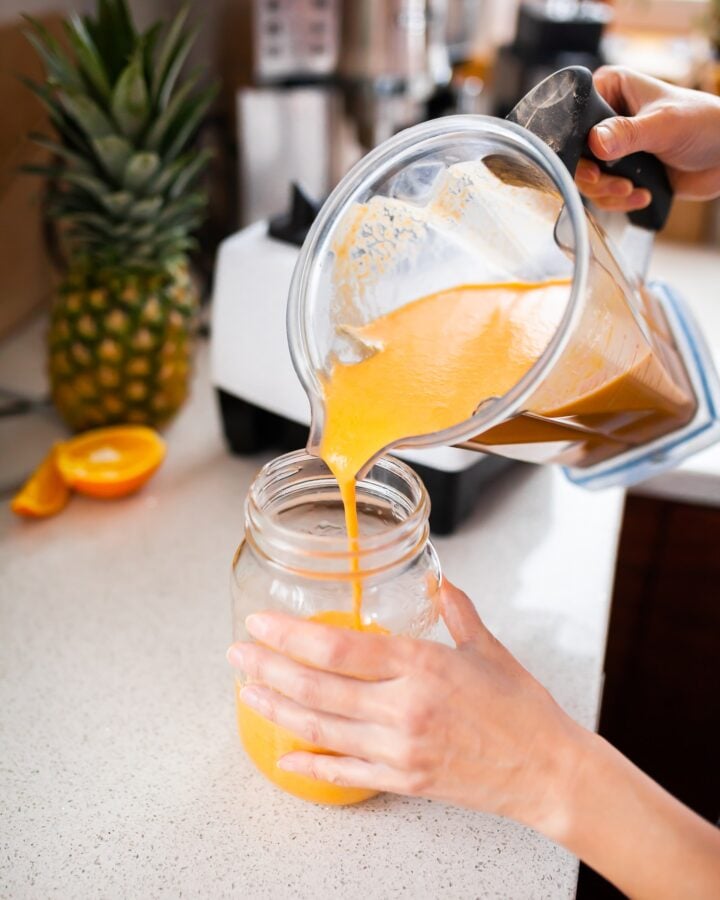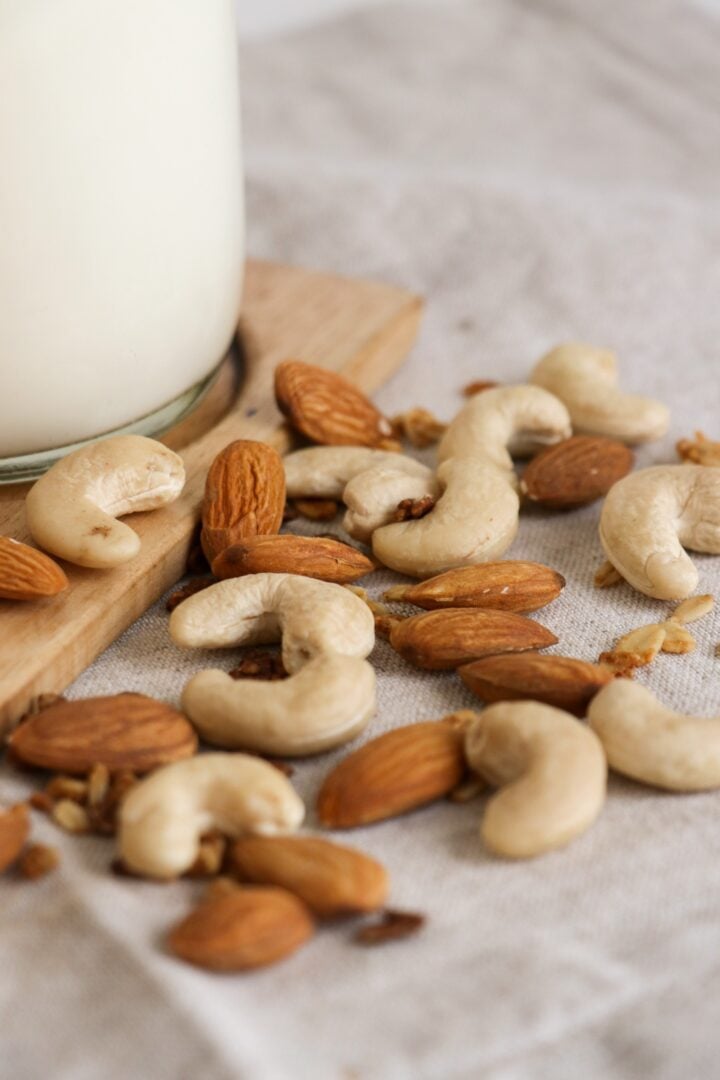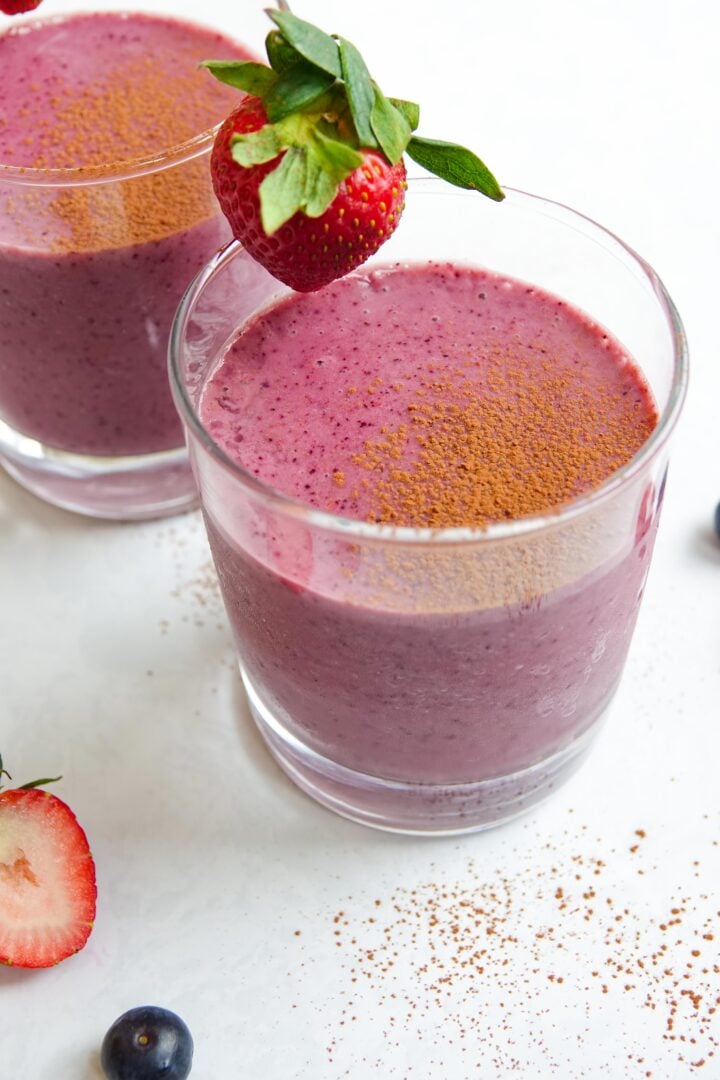How to Add Protein to Smoothies: 19 Dietitian-Approved Ideas
Smoothie lovers (and actually… smoothie haters), it’s time we chat about protein.
More specifically, I want to share my dietitian tricks and tips on how to add protein to smoothies. Because all too often I see people making delicious but totally unbalanced smoothies that leave them feeling hungry, cranky, and with worse cravings than ever before.
In this article, I’ll share exactly how I recommend adding protein to smoothies as a dietitian.
I’ve included 19 protein-rich foods to make your smoothies filling, balanced, and truly nutritious. And I’ll explain how to use these ingredients in some of my favorite, simple smoothie recipes that support your health.
If you thought you hated smoothies because they never keep you full… stick around! This article is going to change your smoothie game forever.

Why is it healthy to add protein to smoothies?
Smoothies are one of my favorite foods to recommend as a dietitian because they’re one of the easiest ways to add fruits, vegetables, and nourishing nutrition to your life.
But there’s kind of a right and a wrong way to do them when the goal is better health.
Many smoothies are made with fresh or frozen fruit, juices, and/or plant-based milks. Don’t get me wrong, these ingredients are delicious and all foods can fit in a healthy relationship with food. But without a solid source of protein paired with them, they also make for a carb-heavy smoothie that will leave you hungry and sluggish minutes later.
It is healthy to add protein to smoothies because it helps balance blood sugar. When you pair a delicious fruit smoothie with protein, you’ll benefit from more stable energy levels, a balanced snack that keeps you full for longer, and better gains in the gym.
Protein matters for healthy smoothies, but it’s not all that matters. Read this article to learn the best add-ins for a healthy smoothie.
Do I need to use protein powder in my smoothie?
You don’t need to use protein powder in smoothies. But you can if you want to!
If you’ve read my articles about greens powders and sea moss, you’ll know I’m picky about my supplements and sceptical about any extreme claims. But in the world of superfood powders and miracle cures, I actually view protein powder as a pretty helpful option.
The way I see it: protein powder can help you eat more protein if you struggle to do so with food alone. It can be a helpful way to boost protein without having to eat mountains of greek yogurt or chicken breast.
But it’s also not necessary. Protein powders can be expensive and not always well-tolerated. And when you use whole foods for protein, you’ll benefit from other nutrients and compounds in the food. So if you’d prefer to get your protein through whole foods alone, that’s okay too!
If you choose to go the protein powder route, I’d recommend choosing one that’s third-party tested and low in added sugars. This whey protein powder or this plant-based blend would both be great options.
Please note that these are affiliate links. If you choose to purchase through these or other product links on my website, I may earn a small commission at no additional cost to you.
How to add protein to smoothies
Here’s your dietitian-approved list of 19 ways to add protein to smoothies.
I’d recommend saving or printing out this list, and writing down 2-3 protein options that work for your budget, lifestyle, and preferences.
The foods are listed in order of highest to lowest protein content. For some of the foods less rich in protein, it may be best to pair that food with another solid protein source to make sure your smoothie is filling and balanced.
Also please note that any nutritional information listed was taken from Canadian Nutrient File or FoodData Central. But values will often change slightly depending on the exact brand and variety you’re purchasing, so always check the nutrition facts table!
I’ve sprinkled a few of my favorite high-protein smoothie recipes throughout this post. And scroll down to the bottom for other important tips for adding protein to smoothies.
Protein powder
It’s not necessary to use protein powder in smoothies but it can help! Especially considering most varieties contain between 20-30 grams of protein per serving. If you can tolerate dairy, whey protein isolate is a great option. Or look for a plant-based protein blend with a few different protein sources in one, like pea and rice protein combined.
How to use it: Add a scoop of flavored or unflavored protein powder to your smoothie before blending. Look for options with little to no added sugar.
Protein shake
Like protein powder, pre-mixed liquid protein shakes are an efficient and tasty way to add protein to your smoothies while also making them easier to blend. Protein shakes contain anywhere from 15 to 42 grams of protein per bottle! Look for options with less than 10 grams of added sugar when possible.
How to use it: Add a bottle of your favorite protein shake to a blender with a half banana and 1 cup of mixed frozen berries.
Collagen peptides
Collagen is a cool ingredient if it fits your budget, but it’s absolutely not necessary! Collagen is an incomplete protein with some research to support its use for skin health, bone health, and healthy joints. One serving of collagen peptides has 18 grams of protein… but it’s an incomplete protein, so don’t rely on it for muscle growth.
How to use it: Add a serving of collagen peptides to your smoothie just as you would any other protein powder. It’s usually unflavored, so include tasty fruits in there too.

Cottage cheese
If you want your smoothie to taste like cheesecake and keep you full for hours, cottage cheese is your best bet. Half cup of cottage cheese contains a whopping 15 grams of complete protein and beneficial micronutrients like calcium and zinc.
How to use it: For a cheesecake smoothie, add a ½ cup scoop of cottage cheese to a blender with ½ cup frozen pitted cherries, ½ cup frozen mango chunks, 1 tablespoon of ground flaxseed, and a scoop of vanilla protein powder. Yum!
Plain greek yogurt
Unsweetened greek yogurt is one of the best sources of protein out there, with an incredible 13 grams per half cup serving (for non-fat varieties)! Greek yogurt has a thick, smooth texture that improves the mouthfeel of smoothies and makes them much more satisfying too.
How to use it: Add ½ cup of plain greek yogurt to smoothies before adding liquid. If you need extra sweetness, add 1-2 tsp of honey or a small medjool date too.
Plain kefir
Kefir is a fermented drink made from milk. A 1 cup serving of kefir contains 9 grams of protein. And it contains live cultures, which can support a more diverse gut microbiome and long-term gut health. Did I mention it’s got calcium too?
How to use it: Try this gut-healthy smoothie with 1 cup of plain kefir, ½ cup frozen peaches, ½ cup frozen strawberries, 1 tablespoon of chia seeds, and a splash of orange juice.
Milk
Milk is an underrated source of nutrition and protein! Just one cup of 2% cow’s milk contains over 8 grams of protein to help balance smoothies and keep you full. Milk is also a natural source of many important micronutrients like calcium, vitamin B12, and phosphorus.
How to use it: Freeze milk in an ice cube tray and add a few to your smoothies before blending for some extra protein and a thicker texture.
Skim milk powder
Did you know that 4 tablespoons of skim milk powder has 9 grams of protein? For 90 calories, that’s not bad at all! It’s also a good source of calcium, super easy to find, and relatively inexpensive. It’s got a nice, mild, milky taste too.
How to use it: Add 4 tablespoons of skim milk powder to a smoothie along with any liquid of choice. Add a second source of protein if the smoothie is a full meal.
White beans
I know the idea of beans in your smoothie sounds a little strange… but stay with me! A half cup of white beans contains 9 grams of protein. Even better? That serving also contains over 6 grams of fiber to improve your digestion and keep you even more full.
How to use it: Add ¼ cup of rinsed (no-salt added) canned white beans to your strawberry banana smoothie with 1 small banana, ½ cup frozen strawberries, ½ scoop of vanilla protein powder, and a milk of choice.
Peanut butter
Natural peanut butter contains up to 8 grams of protein per 2 tablespoon serving. Peanut butter is a source of healthy fats too, which makes it calorie-dense. I’d recommend measuring out your serving if you’re working toward weight loss goals.
How to use it: Add 1-2 tablespoons of peanut butter to a smoothie with another protein source like milk, soy milk, or cottage cheese.
Almond butter
Almond butter is another incredible source of healthy fats with an added boost of protein! Two tablespoons of almond butter has 7 grams of protein. And it contains fiber, vitamin E, iron, and even some calcium!
How to use it: Try this almond butter cup smoothie with 2 tablespoons of almond butter, 1 cup soy milk, 1 small frozen banana, and a scoop of chocolate protein powder. You could add ⅓ cup frozen riced cauliflower for a veggie boost too.
Unsweetened soy milk
Soy ‘milk’ or soy beverage is an awesome plant-based alternative to traditional dairy milk. It’s got up to 7 grams of protein per cup. It’s often fortified with vitamin D and calcium too! I’d recommend choosing unsweetened soy milk to reduce added sugar intake.
How to use it: Use ½ to 1 cup of soy milk as the liquid in your fruit smoothies for a boost of protein and a thinner, sippable texture.
Silken tofu
Silken tofu is undrained and unpressed, which makes for a softer tofu with more moisture than firm varieties. Its soft texture and mild taste makes it the perfect nourishing addition to smoothies. And it’s got 6 grams of protein per half cup serving.
How to use it: Add a slice of silken tofu right to your blender with your favorite fruits! Pair with 2 tablespoons of hemp seeds or some unsweetened soy milk for extra protein.
Cashews
A quarter cup of cashews contains 6 grams of protein and 182 calories. Cashews are known for their healthy fat content, which is why they’re a bit more calorie-dense than other protein options to add to smoothies. Cashews are a good source of copper, magnesium, and zinc.
How to use it: Add ¼ cup raw and unsalted cashews to your smoothie along with 1 cup frozen blueberries, 1 pitted medjool date, 1 cup of soy milk, and a pinch of salt.

Hemp seeds
Another amazing protein booster to the rescue! Two tablespoons of hemp seeds has over 6 grams of plant-based protein. It also contains omega-3 fatty acids, which can promote heart health and brain health.
How to use it: Add 2 tablespoons of hemp hearts to any smoothie for an extra protein boost.
Powdered peanut butter
Powdered peanut butter (usually seen as the brand PB2) is a tasty and delicious way to add protein to smoothies. Two tablespoons of powdered peanut butter contains 6 grams of protein and only 60 calories. And it adds a delicious nutty taste without being so calorie-dense!
How to use it: Try a PB&J smoothie with 2 tablespoons of powdered peanut butter, 1 tablespoon peanut butter, ½ cup frozen grapes, ½ cup frozen berries, vanilla protein powder, and liquid of choice.
Raw oats
Oats are mostly known as a carbohydrate source with fiber to support your heart health and digestion. But they actually contain protein too… 4 grams of plant-based protein per ⅓ cup serving to be exact. Don’t rely on oats alone for your protein source in smoothies, but it’s a great ingredient to add for an extra boost.
How to use it: Add ¼ cup uncooked oats to your smoothie with another source of protein like greek yogurt, cottage cheese, or protein powder.
Chia seeds
Chia seeds are known for their impressive fiber content and healthy fats, but did you know they contain some protein too? A 2 tablespoon serving of chia seeds contains up to 4 grams of plant-based protein. I wouldn’t recommend relying on chia seeds alone for the protein in your smoothies… but when paired with another source like silken tofu or soy milk, they offer a great boost!
How to use it: Add 1-2 Tbsp of chia seeds to any smoothie along with an extra ½ cup of liquid. Chia seeds absorb a lot of water and extra liquid helps combat a too-thick texture!
Ground flaxseed
Flaxseeds contain heart-healthy fat and fiber, as well as micronutrients like thiamine, copper, and phosphorus. Two tablespoons of ground flaxseeds contains 2 grams of plant-based protein too! Obviously, that’s not enough to serve as your main protein source in smoothies… but it’s another great protein booster!
How to use it: Add 2 tablespoons of ground flaxseed to a mixed berry smoothie with 1 cup frozen mixed berries, 1 cup milk, ¼ cup oats, and 1 scoop of vanilla protein powder.
More tips to add protein to smoothies
Adding protein to smoothies is so important for fullness, energy, and fitness goals.
The 19 foods listed above can help, and so can these easy tips:
- Double-up on protein sources. The more protein, the better… and the more nutrition, the better! Aim to get protein from two or more sources in your smoothies for an extra boost of protein and nutrients.
- Choose higher protein milks. Although coconut, almond, and cashew ‘milks’ are delicious, they’re lacking in the protein department. Choose dairy milk, soy milk, or pea milk (some brands have higher protein) when possible.
- Aim for 15-30 grams of protein per smoothie. For snack-sized smoothies, 15 grams of protein will do! For meal-sized smoothies, aim for 30 or more grams of protein.
I also encourage you to rely on whole foods more than you do powders.
As we talked about earlier in this article, protein powders and supplements can be a helpful way to meet protein goals. But the benefit of whole food sources of protein is that they contain other beneficial compounds, phytonutrients, and micronutrients to keep us satisfied and enhance health.
A simple rule of thumb: choose whole foods most and use protein powders as needed.

More healthy high protein smoothie recipes
- Chocolate berry smoothie
- Strawberry raspberry smoothie
- Blueberry and pineapple smoothie
- Pineapple banana smoothie
- Banana peach smoothie
Final thoughts
It’s important to add protein to smoothies for your short-term energy and long-term health.
Adding protein to smoothies will help you feel more full, experience more stable energy, reduce cravings, and support fitness goals. In the long-term, a protein-rich diet can help you feel more mindful with food, prevent muscle loss, and even support weight loss.
Save this article to improve your smoothie game and learn how to add more protein to smoothies!
And don’t forget to grab some free dietitian-created resources before you go: 70 convenience foods to make healthy eating easier, the ultimate list of 90+ high-fiber foods, and your checklist and guided journal to understand and overcome overeating.

